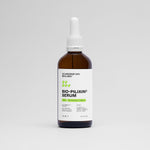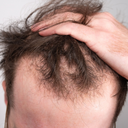Coarse hair is often a term used to describe hair that has a thicker diameter compared to other hair types. This hair type can be both a blessing and a challenge, as it offers unique characteristics that require specific care and styling techniques. In this article, we will explore what coarse hair is, its defining traits, how to care for it, and tips to manage and style it effectively.
Table of content
What is coarse hair?
Coarse hair is defined by its thickness and texture. It typically has a larger diameter than fine or medium hair, which can result in a more robust and resilient strand. This hair type is often less prone to damage and breakage, thanks to its sturdy structure. However, coarse hair can also be more challenging to manage, as it tends to be drier and more susceptible to frizz. Understanding your coarse hair is vital for developing an effective hair care routine that enhances its natural beauty.
As your leading source for hair health information over the past 4 years, we never compromise on accuracy. When it comes to your health, you deserve information you can truly rely on - and earning your trust is our top priority.
Here's how Scandinavian Biolabs ensures every piece of content meets the highest standards of accuracy and integrity:
- Credentialed Experts: Our reviewers are actively practicing doctors and medical researchers
- Stringent Reviews: Content undergoes rigorous editing by subject specialists and review by a practicing doctor.
- Evidence-Based: We rely on well-established research from trusted scientific sources like peer-reviewed journals and health authorities.
- Full Transparency: Our editorial standards, writer credentials, reviewer credentials, correction process, and funding are all publicly documented.
- Independent Voice: While we do promote products, we operate in a vacuum to business operations. Our main goal is just an unwavering commitment to providing medically-sound guidance.
You can count on Scandinavian Biolabs to consistently deliver the trustworthy health information you deserve. Read our Editorial Standards.
Characteristics of coarse hair
Coarse hair is identifiable by several distinct characteristics:
- Thickness: Coarse hair strands are thicker than fine or medium hair strands, making them feel sturdier.
- Texture: It often has a rougher texture, which can contribute to a more voluminous look.
- Frizz: Coarse hair is more prone to frizz, especially in humid conditions, requiring special care to maintain smoothness.
- Moisture retention: This hair type tends to be drier due to its structure, which can make it more challenging to retain moisture.
- Styling: Coarse hair can hold styles well but may require more effort to manage and style compared to finer hair types.
How to care for coarse hair
Caring for coarse hair involves a few key strategies to keep it healthy and manageable:
1. Use the right products
Choosing the right hair products is crucial for maintaining the health of coarse hair. Look for moisturizing shampoos and conditioners specifically designed for dry or coarse hair. These products help to hydrate and soften the strands, making them easier to manage.
2. Deep conditioning treatments
Incorporate deep conditioning treatments into your hair care routine at least once a week. These treatments provide intense moisture and nourishment, which is essential for coarse hair. Opt for products that contain natural oils, such as argan or coconut oil, to enhance shine and reduce frizz.
3. Limit heat styling
Heat styling tools can be harsh on coarse hair, leading to dryness and damage. Whenever possible, limit the use of blow dryers, flat irons, and curling wands. If you must use heat, always apply a heat protectant to shield your hair from potential damage.
4. Regular trims
Regular haircuts are essential for maintaining the health of coarse hair. Trimming the ends every 6-8 weeks helps to remove split ends and prevent further breakage. This ensures that your hair remains healthy and looks its best.
5. Embrace natural drying
Allowing your hair to air dry instead of blow drying can help retain moisture and reduce frizz. If you prefer to use a blow dryer, use a diffuser attachment on a low heat setting to minimize damage.
Styling coarse hair
Styling coarse hair can be a unique experience, and with the right techniques, you can achieve stunning looks:
1. Use the right tools
Invest in high-quality brushes and combs designed for coarse hair. Wide-tooth combs work well for detangling, while boar bristle brushes can help distribute natural oils along the hair shaft, enhancing shine.
2. Experiment with products
Styling creams, gels, and mousses can help define curls and waves in coarse hair. Choose products that provide hold without making your hair feel crunchy or stiff. Look for lightweight formulas that allow your natural texture to shine.
3. Protective hairstyles
Consider styles that protect your hair from daily wear and tear. Braids, buns, and updos can help minimize damage and keep your hair looking polished. Just be sure not to pull too tightly, as this can lead to breakage.
4. Embrace your natural texture
Coarse hair often has a beautiful texture that can be enhanced with the right products. Embrace your natural waves or curls by using curl-enhancing products and avoiding excessive heat styling.
Conclusion
Coarse hair, with its unique characteristics and challenges, can be a beautiful asset when properly cared for. By understanding what coarse hair is and implementing the right care and styling techniques, you can achieve healthy, vibrant locks that showcase your natural beauty. Remember to choose the right products, maintain a regular hair care routine, and embrace your hair's natural texture. With dedication and the right knowledge, coarse hair can be both manageable and stunning.
```Tired of Thinning Hair? Try a Clinically Tested Serum.
Looking for a natural way to regrow hair and achieve a thicker, fuller head of hair? Ditch the stinging nettle for hair loss – Bio-Pilixin Serum is a drug-free hair activation serum that delivers clinically tested results.
Here's why Bio-Pilixin is superior:
- Clinically Tested Results: 93% of users saw a reduction in hair loss, and 73% experienced increased hair density.
- Safe and Natural: Unlike harsh chemicals, Bio-Pilixin uses plant growth factors derived from stem cell technology to nourish hair follicles and stimulate growth.
- Fast-Acting: See visible results in as little as 45 days (most typically see results within 150 days).
Stop wasting time on unproven remedies. Bio-Pilixin is the safe & effective serum you've been searching for.
Read more:






